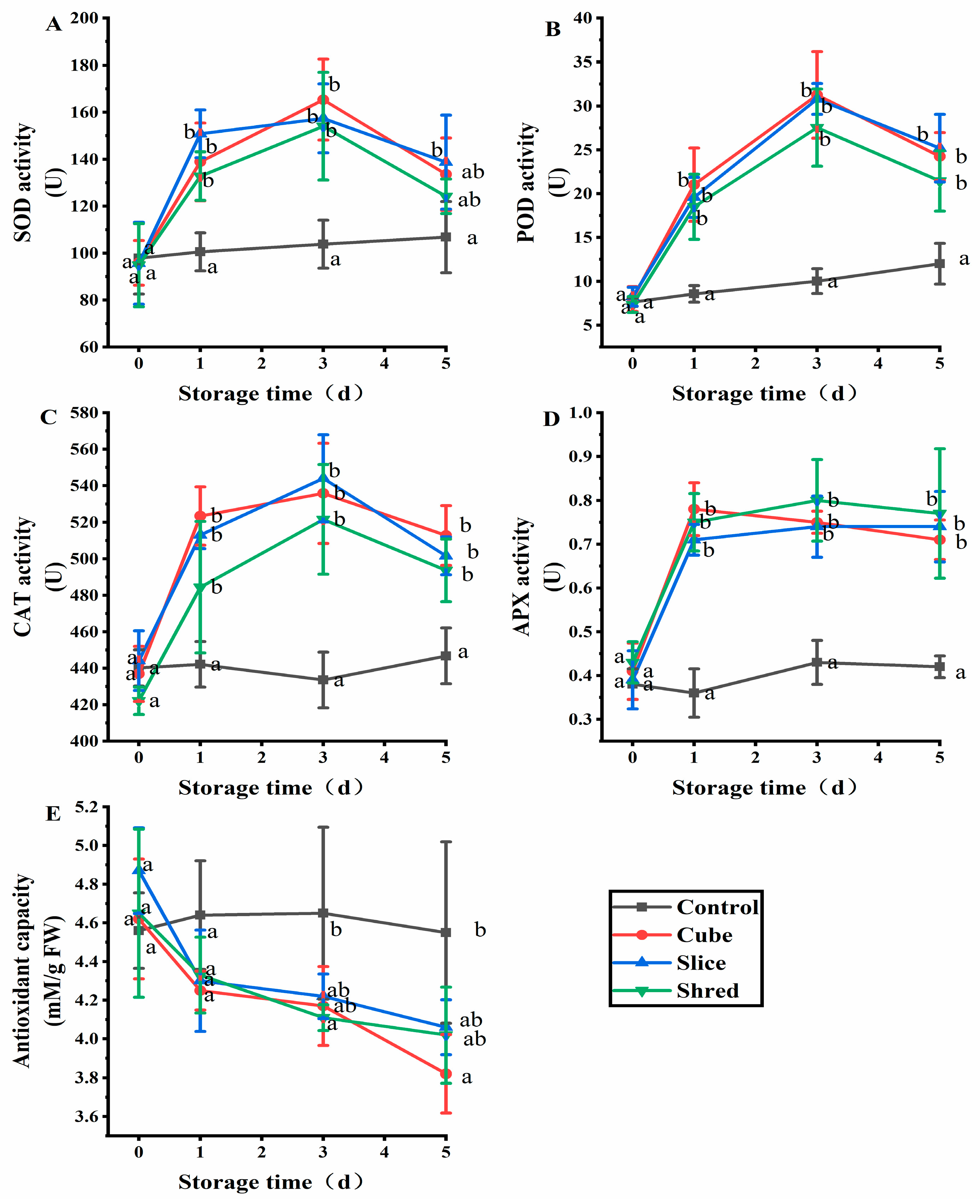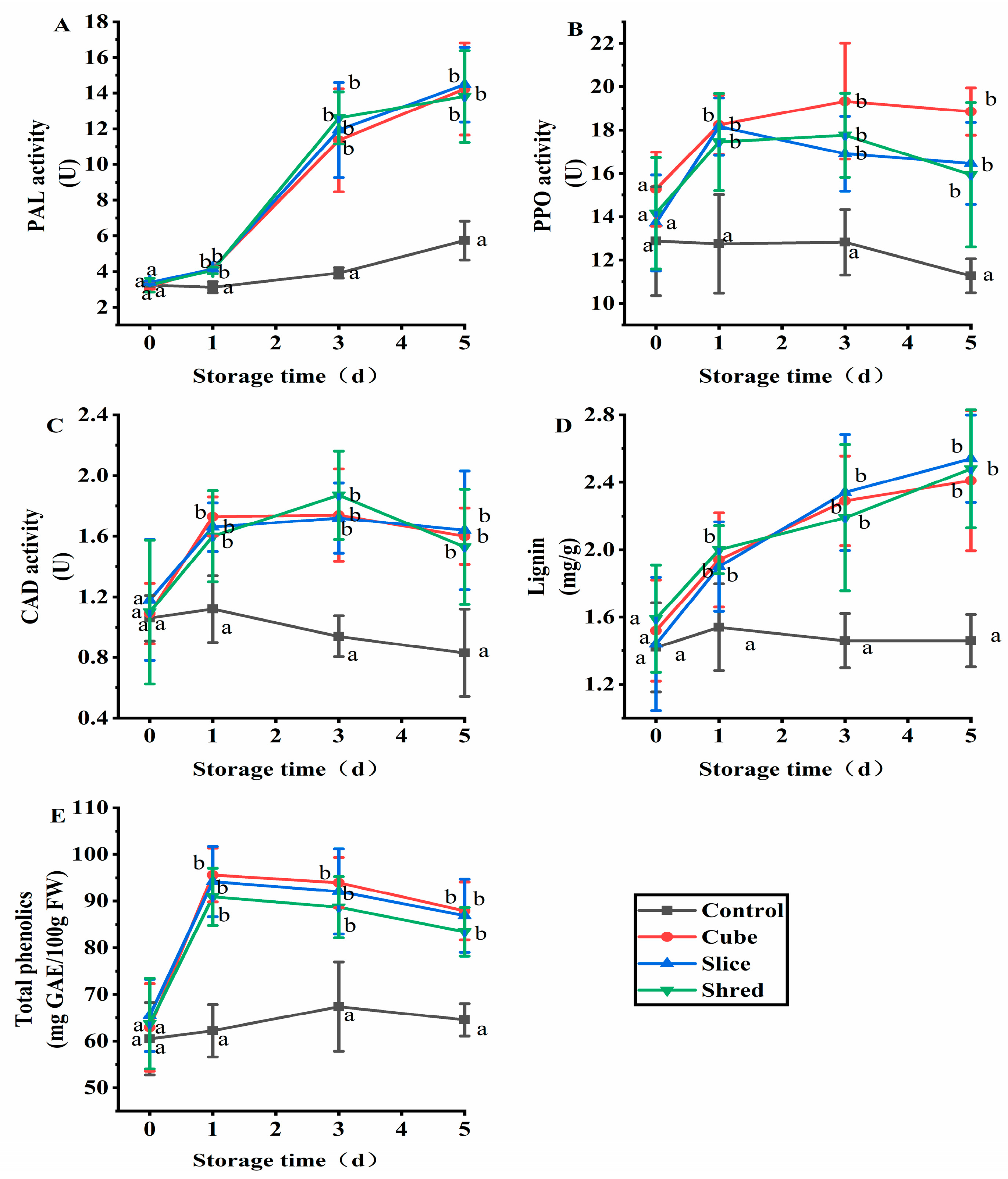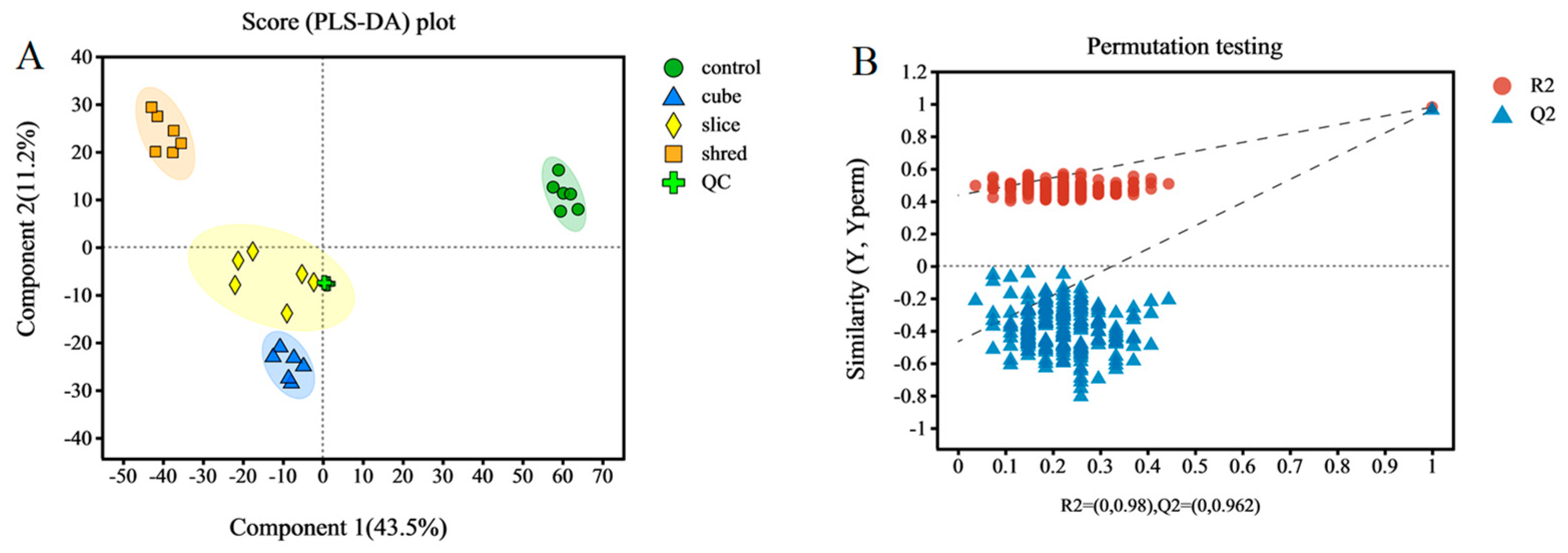Effects of Different Cutting Styles on Physiological Properties in Fresh-Cut Carrots
Abstract
1. Introduction
2. Results and Discussion
2.1. Effect of Cutting Style on H2O2, O2−, and Malondialdehyde (MDA) Content of Fresh-Cut Carrots during Storage
2.2. Effect of Cutting Style on Antioxidant Enzymes and Antioxidant Capacity of Fresh-Cut Carrots during Storage
2.3. Effect of Cutting Style on Phenylalanine Ammonia-Lyase (PAL), Polyphenoloxidase (PPO), Cinnamyl-Alcoholdehydrogenase (CAD), Lignin, and Total Phenol Content of Fresh-Cut Carrots during Storage
2.4. Metabolomic Changes
3. Materials and Methods
3.1. Sample Processing
3.2. Enzyme Activity Assay
3.3. Reactive Oxygen (ROS), Malondialdehyde, and Lignin Determination
3.4. Polyphenol and Antioxidant Activity Assay
3.5. Metabolomic Analysis
3.6. Statistical Analysis
4. Conclusions
Author Contributions
Funding
Data Availability Statement
Conflicts of Interest
References
- Hu, W.; Guan, Y.; Wang, Y.; Yuan, N. Effect of Wounding Intensity on Edible Quality by Regulating Physiological and ROS Metabolism in Fresh-Cut Pumpkins. Horticulturae 2023, 9, 512. [Google Scholar] [CrossRef]
- Shi, C.; Shen, S.-w.; Sun, Y.; Liu, E.-q.; Gong, H.; Ni, Z.-z.; He, Y. Effect of cutting styles on physicochemical properties and antioxidant capacity of fresh-cut kiwifruits (Actinidia spp.). J. Food Meas. Charact. 2023, 18, 550–559. [Google Scholar] [CrossRef]
- Guan, Y.; Hu, W.; Wang, L.; Yang, B. Different Cutting Methods Affect the Quality of Fresh-Cut Cucumbers by Regulating ROS Metabolism. Horticulturae 2023, 9, 514. [Google Scholar] [CrossRef]
- Zuo, W.; Lu, L.; Su, M.; Zhang, J.; Li, Y.; Huang, S.; Li, C.; Wang, N.; Zhang, Z.; Chen, X. Analysis of differentially expressed genes and differentially abundant metabolites associated with the browning of Meihong red-fleshed apple fruit. Postharvest Biol. Technol. 2021, 174, 111437. [Google Scholar] [CrossRef]
- Zhou, Y.; Fichman, Y.; Zhang, S.; Mittler, R.; Chen, S.-J. Modeling the Reactive Oxygen Species (ROS) wave in Chlamydomonas reinhardtii colonies. Free Radic. Biol. Med. 2024. [Google Scholar] [CrossRef] [PubMed]
- Petrov, V.; Hille, J.; Mueller-Roeber, B.; Gechev, T.S. ROS-mediated abiotic stress-induced programmed cell death in plants. Front. Plant Sci. 2015, 6, 69. [Google Scholar] [CrossRef]
- Qi, J.; Song, C.P.; Wang, B.; Zhou, J.; Kangasjärvi, J.; Zhu, J.K.; Gong, Z. Reactive oxygen species signaling and stomatal movement in plant responses to drought stress and pathogen attack. J. Integr. Plant Biol. 2018, 60, 805–826. [Google Scholar] [CrossRef]
- Mittler, R.; Zandalinas, S.I.; Fichman, Y.; Van Breusegem, F. Reactive oxygen species signalling in plant stress responses. Nat. Rev. Mol. Cell Biol. 2022, 23, 663–679. [Google Scholar] [CrossRef]
- Du, M.; Lian, L.; Zhang, Y.; Lin, H.; Wang, J. Roles of ROS metabolism and phenylpropanoid pathway in quality maintenance of postharvest Pleurotus eryngii under hyperoxia stress. Postharvest Biol. Technol. 2024, 207, 112617. [Google Scholar] [CrossRef]
- Hu, W.; Guan, Y.; Ji, Y.; Yang, X. Effect of cutting styles on quality, antioxidant activity, membrane lipid peroxidation, and browning in fresh-cut potatoes. Food Biosci. 2021, 44, 101435. [Google Scholar] [CrossRef]
- Lim, S.D.; Kim, S.-H.; Gilroy, S.; Cushman, J.C.; Choi, W.-G. Quantitative ROS bioreporters: A robust toolkit for studying biological roles of ROS in response to abiotic and biotic stresses. Physiol. Plant 2019, 165, 356–368. [Google Scholar] [CrossRef] [PubMed]
- El-Khazandar, A.N. Organo-phosphorus Schiff-bases Part (IV): Synthesis and characteristics of some phosphate Schiff-base complexes. Phosphorus Sulfur Silicon Relat. Elem. 1997, 126, 243–255. [Google Scholar] [CrossRef]
- Sahu, P.K.; Jayalakshmi, K.; Tilgam, J.; Gupta, A.; Nagaraju, Y.; Kumar, A.; Hamid, S.; Singh, H.V.; Minkina, T.; Rajput, V.D.; et al. ROS generated from biotic stress: Effects on plants and alleviation by endophytic microbes. Front. Plant Sci. 2022, 13, 1042936. [Google Scholar] [CrossRef] [PubMed]
- Li, X.; Jiang, Y.; Liu, Y.; Li, L.; Liang, F.; Wang, X.; Li, D.; Pan, N.; Li, X.; Yang, X.; et al. Effects of Short-Term High Oxygen Pre-Stimulation on Browning Resistance and Low-Temperature Tolerance of Fresh-Cut Potatoes in Supercooled Storage. Food Bioproc. Technol. 2023, 17, 709–721. [Google Scholar] [CrossRef]
- Liang, J.; Guo, F.; Cao, S.; Zhao, K.; Zhao, K.; Wang, H.; Shao, X.; Wei, Y.; Zhang, C.; Zheng, Y.; et al. γ-aminobutyric acid (GABA) alleviated oxidative damage and programmed cell death in fresh-cut pumpkins. Plant Physiol. Biochem. 2022, 180, 9–16. [Google Scholar] [CrossRef] [PubMed]
- Li, Z.-Q.; Li, J.-X.; Zhang, G.-F. Expression regulation of plant ascorbate peroxidase and its tolerance to abiotic stresses. Yichuan 2013, 35, 45–54. [Google Scholar] [CrossRef] [PubMed]
- Raman, V.; Ravi, S. Effect of salicylic acid and methyl jasmonate on antioxidant systems of Haematococcus pluvialis. Acta Physiol. Plant 2010, 33, 1043–1049. [Google Scholar] [CrossRef]
- Li, X.; Long, Q.; Gao, F.; Han, C.; Jin, P.; Zheng, Y. Effect of cutting styles on quality and antioxidant activity in fresh-cut pitaya fruit. Postharvest Biol. Technol. 2017, 124, 1–7. [Google Scholar] [CrossRef]
- Stadnik, M.J.; Buchenauer, H. Inhibition of phenylalanine ammonia-lyase suppresses the resistance induced by benzothiadiazole in wheat to Blumeria graminis f. sp. tritici. Physiol. Mol. Plant Pathol. 2000, 57, 25–34. [Google Scholar] [CrossRef]
- Surjadinata, B.B.; Cisneros-Zevallos, L. Biosynthesis of phenolic antioxidants in carrot tissue increases with wounding intensity. Food Chem. 2012, 134, 615–624. [Google Scholar] [CrossRef]
- Sarker, U.; Islam, M.T.; Rabbani, M.G.; Oba, S. Variability in total antioxidant capacity, antioxidant leaf pigments and foliage yield of vegetable amaranth. J. Integr. Agric. 2018, 17, 1145–1153. [Google Scholar] [CrossRef]
- Whitaker, J.R. Principles of Enzymology for the Food Sciences; Routledge: London, UK, 2018. [Google Scholar]
- Veltman, R.H.; Larrigaudiere, C.; Wichers, H.J.; van Schaik, A.C.R.; van der Plas, L.H.W.; Oosterhaven, J. PPO Activity and Polyphenol Content are not Limiting Factors During Brown Core Development in Pears (Pyrus communis L. cv. Conference). J. Plant Physiol. 1999, 154, 697–702. [Google Scholar] [CrossRef]
- Zhang, J.; Sun, X. Recent advances in polyphenol oxidase-mediated plant stress responses. Phytochemistry 2021, 181, 112588. [Google Scholar] [CrossRef]
- Gacnik, S.; Veberic, R.; Marinovic, S.; Halbwirth, H.; Mikulic-Petkovsek, M. Effect of pre-harvest treatments with salicylic and methyl salicylic acid on the chemical profile and activity of some phenylpropanoid pathway related enzymes in apple leaves. Sci. Hortic. 2021, 277, 109794. [Google Scholar] [CrossRef]
- Saberi Riseh, R.; Fathi, F.; Lagzian, A.; Vatankhah, M.; Kennedy, J.F. Modifying lignin: A promising strategy for plant disease control. Int. J. Biol. Macromol. 2024, 271, 132696. [Google Scholar] [CrossRef] [PubMed]
- Lei, M.; Wu, S.; Liu, C.; Liang, J.; Xiao, R. Revealing the pyrolysis behavior of 5-5′ biphenyl-type lignin fragment. Part I: A mechanistic study on fragmentation via experiments and theoretical calculation. Fuel Process. Technol. 2021, 217, 106812. [Google Scholar] [CrossRef]
- Zhang, X.; Yang, R.; Zheng, X.; Wang, Q.; Silvy, E.M.; Li, Y.; Han, Y.; Bi, Y.; Prusky, D. UV-C irradiation accelerated the deposition of suberin and lignin at wounds by activating phenylpropanoid metabolism in potato tubers. Sci. Hortic. 2023, 309, 111634. [Google Scholar] [CrossRef]
- Liu, Y.; Ge, Y.; Bi, Y.; Li, C.; Deng, H.; Hu, L.; Dong, B. Effect of postharvest acibenzolar-S-methyl dipping on phenylpropanoid pathway metabolism in muskmelon (Cucumis melo L.) fruits. Sci. Hortic. 2014, 168, 113–119. [Google Scholar] [CrossRef]
- Wilson, M.D.; Stanley, R.A.; Eyles, A.; Ross, T. Innovative processes and technologies for modified atmosphere packaging of fresh and fresh-cut fruits and vegetables. Crit. Rev. Food Sci. Nutr. 2017, 59, 411–422. [Google Scholar] [CrossRef]
- Shen, X.; Li, X.; Jia, C.; Li, J.; Chen, S.; Gao, B.; Liang, W.; Zhang, L. HPLC-MS-based untargeted metabolomic analysis of differential plasma metabolites and their associated metabolic pathways in reproductively anosmic black porgy, Acanthopagrus schlegelii. Comp. Biochem. Physiol. Part D Genom. Proteom. 2023, 46, 101071. [Google Scholar] [CrossRef]
- Wang, J.; Cui, Y.; Zhang, M.; Wang, L.; Aihaiti, A.; Maimaitiyiming, R. Pulsed-control plasma-activated water: An emerging technology to assist ultrasound for fresh-cut produce washing. Ultrason. Sonochem. 2024, 102, 106739. [Google Scholar] [CrossRef] [PubMed]
- Zhang, J.; Zhao, J.; Zuo, X.; You, W.; Ru, X.; Xu, F.; Jin, P.; Zheng, Y.; Cao, S. Glutamate application maintains quality and antioxidant capacity of fresh-cut carrots by modulating GABA shunt, phenylpropanoid and ROS metabolism. Food Chem. 2024, 443, 138545. [Google Scholar] [CrossRef]
- Rumpf, J.; Burger, R.; Schulze, M. Statistical evaluation of DPPH, ABTS, FRAP, and Folin-Ciocalteu assays to assess the antioxidant capacity of lignins. Int. J. Biol. Macromol. 2023, 233, 123470. [Google Scholar] [CrossRef] [PubMed]
- Zhang, J.; Zuo, X.; Li, Y.; Ru, X.; You, W.; Xu, F.; Jin, P.; Zheng, Y.; Cao, S. Calcium chloride treatment maintains quality and enhances antioxidant capacity of fresh-cut carrots through modulating DcCMLs-DcCAMTA3-mediated phenylpropanoid pathway. Postharvest Biol. Technol. 2024, 209, 112714. [Google Scholar] [CrossRef]
- Kenny, O.; O’Beirne, D. Antioxidant phytochemicals in fresh-cut carrot disks as affected by peeling method. Postharvest Biol. Technol. 2010, 58, 247–253. [Google Scholar] [CrossRef]
- Du, W.X.; Avena-Bustillos, R.J.; Breksa, A.P., 3rd; McHugh, T.H. Effect of UV-B light and different cutting styles on antioxidant enhancement of commercial fresh-cut carrot products. Food Chem. 2012, 134, 1862–1869. [Google Scholar] [CrossRef]
- Gao, Y.; Yu, T.; Ai, F.; Ji, C.; Wu, Y.; Huang, X.; Zheng, X.; Yan, F. Bacillus coagulans XY2 ameliorates copper-induced toxicity by bioadsorption, gut microbiota and lipid metabolism regulation. J. Hazard. Mater. 2023, 445, 130585. [Google Scholar] [CrossRef]





| Treatment | KEGG Pathway Description | p-Value | Metabolite |
|---|---|---|---|
| Cube | Phenylpropanoid biosynthesis | 0.04547 | Cinnamaldehyde, Ferulic acid, Trans-Chlorogenic acid, 5-p-Coumaroylquinic acid, Coniferyl alcohol, P-Coumaraldehyde, Chavicol, 4-Vinylphenol, Coniferin, 1-O-Sinapoyl-beta-D-glucose |
| Isoflavonoid biosynthesis | 0.04768 | Liquiritigenin *, Glyceollin II *, 6″-Malonylgenistin * | |
| Carotenoid biosynthesis | 0.04768 | (S)-Abscisic acid, (+)-cis-abscisic aldehyde, Abscisic Acid, Dihydrophaseic acid | |
| Slice | Carotenoid biosynthesis | 0.02913 | (S)-Abscisic acid, (+)-cis-abscisic aldehyde, Abscisic Acid, Dihydrophaseic acid |
| Flavonoid biosynthesis | 0.03148 | (+)-Gallocatechin *, Trans-Chlorogenic acid *, 5-p-Coumaroylquinic acid, Liquiritigenin, (−)-Epiafzelechin * | |
| Phenylpropanoid biosynthesis | 0.04403 | Cinnamaldehyde, Ferulic acid, Trans-Chlorogenic acid, 5-p-Coumaroylquinic acid, Coniferyl alcohol, P-Coumaraldehyde, Chavicol, 4-Vinylphenol, 5-Hydroxyferulic acid | |
| Shred | Phenylpropanoid biosynthesis | 0.005659 | Cinnamaldehyde, Ferulic acid, Trans-Chlorogenic acid, 5-p-Coumaroylquinic acid, Coniferyl alcohol, P-Coumaraldehyde, Chavicol, Coniferin, 1-O-Sinapoyl-beta-D-glucose, 5-Hydroxyferulic acid, Coniferyl Aldehyde *, Eugenol * |
Disclaimer/Publisher’s Note: The statements, opinions and data contained in all publications are solely those of the individual author(s) and contributor(s) and not of MDPI and/or the editor(s). MDPI and/or the editor(s) disclaim responsibility for any injury to people or property resulting from any ideas, methods, instructions or products referred to in the content. |
© 2024 by the authors. Licensee MDPI, Basel, Switzerland. This article is an open access article distributed under the terms and conditions of the Creative Commons Attribution (CC BY) license (https://creativecommons.org/licenses/by/4.0/).
Share and Cite
Zhou, N.; Ma, S.; Zhang, M.; Wang, J. Effects of Different Cutting Styles on Physiological Properties in Fresh-Cut Carrots. Plants 2024, 13, 1665. https://doi.org/10.3390/plants13121665
Zhou N, Ma S, Zhang M, Wang J. Effects of Different Cutting Styles on Physiological Properties in Fresh-Cut Carrots. Plants. 2024; 13(12):1665. https://doi.org/10.3390/plants13121665
Chicago/Turabian StyleZhou, Ning, Sen Ma, Minwei Zhang, and Jiayi Wang. 2024. "Effects of Different Cutting Styles on Physiological Properties in Fresh-Cut Carrots" Plants 13, no. 12: 1665. https://doi.org/10.3390/plants13121665
APA StyleZhou, N., Ma, S., Zhang, M., & Wang, J. (2024). Effects of Different Cutting Styles on Physiological Properties in Fresh-Cut Carrots. Plants, 13(12), 1665. https://doi.org/10.3390/plants13121665






